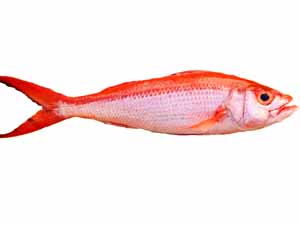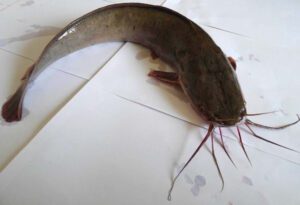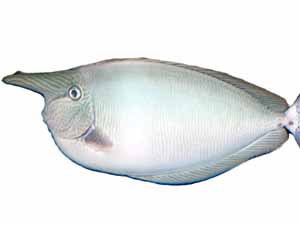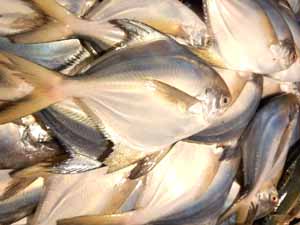The Pink salmon fish is a species of anadromous fish in the salmon family. It is also called Humpback salmon, Humpy or Humpies. It is the smallest and most abundant of the Pacific salmon. It is actually a coldwater fish, and it’s preferred temperature ranges between 5.6 and 14.6 °C.
Native range of these fish is in the Pacific and Arctic coastal waters and rivers (from the Sacramento River in northern California to the Mackenzie River in Canada; and in the west from the Lena River in Siberia to Korea and Honshu in Japan).
NatureServe lists the Pink salmon fish as critically imperiled in California, and imperiled in Washington. And the fish is considered secure in Alaska and British Columbia.
No Pink salmon Evolutionary Significant Units are listed under the Endangered Species Act. However, read some more information about this fish species below.
Pink Salmon Fish Characteristics
The Pink salmon fish are the smallest of the Pacific salmon. They are of bright silver color in the ocean. But the coloring changes to pale grey on the back with yellowish-white belly after returning to their spawning streams (although some turn an overall dull green color).
The Pink salmon fish also have an adipose fin in addition to the dorsal fin, as with all salmon. They are easily characterized by a white mouth with black gums, no teeth on the tongue, large oval-shaped black spots on the back, a v-shaped tail and an anal fin with 13-17 soft rays. The males develop a pronounced humped back during their spawning migration. And their nickname is ‘humpies’ for this humped back.
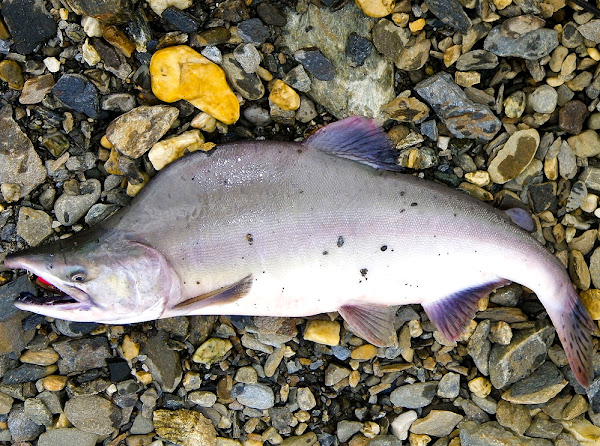
Maximum recorded body length of the Pink salmon fish is around 76 inches. Average body weight of the mature fish is around 2.2 kg, with a maximum recorded weight of 6.8 kg. Photo and info from Wikipedia.
Diet
The fry may sometimes feed on nymphal and larval insects, or none at all while in freshwater. The young feed on copepods and larvacean tunicates in the sea. And their diet shift to amphipods, euphausiids and fishes as they grow.
Breeding
The Pink salmon fish have a strict 2 year life cycle in their native range (thus odd and even-year populations do not interbreed). The adult fish enter spawning streams from the ocean, generally returning to the stream where they originated. Their spawning generally occurs during the late June and mid October in coastal streams and some longer rivers.
The females dig a trough-shaped nest in the gravel of the stream bed by using her tail, which is called a redd. And she lays her eggs there. She is approached by one or more males after laying eggs, and the males fertilize the eggs.
The eggs are often fertilized by several males. On an average the females can lay between 1000 and 2000 eggs in several clutches within the redd. They die after spawning, but they guard their redds until death.
Uses
The Pink salmon fish are used mainly for food. They are often canned, salted or smoked.
Special Notes
The Pink salmon fish are economically very important. They are fished commercially for canning and salting. Unlike other salmon, the Pink salmon are not grown in significant numbers in fish farms. These fish are generally caught by gillnets and trawl nets.
The Pink salmon fish are mostly sold canned and also utilized fresh, frozen and smoked. They are also valued for caviar (especially in Japan), eaten fried, boiled, broiled, steamed, baked and microwaved. However, review full breed profile of the Pink salmon fish in the table below.
| Name | Pink Salmon |
| Kingdom | Animalia |
| Phylum | Chordata |
| Class | Actinopterygii |
| Order | Salmoniformes |
| Family | Salmonidae |
| Genus | Oncorhynchus |
| Species | O. gorbuscha |
| Binomial Name | Oncorhynchus gorbuscha |
| Other Names | Humpback Salmon, Humpy, Humpies and also known by many different names in different parts of the world |
| Breed Purpose | Food |
| Special Notes | Economically important fish species, mainly used for food, commercially very important fish species, not grow in significant numbers in fish farms, generally caught by gillnets and trawl nets, mostly sold canned |
| Breeding Method | Natural |
| Climate Tolerance | Native climates |
| Body Color | Bright silver color in the ocean, but coloring changes to pale grey on the back with yellowish-white belly after returning to their spawning streams |
| Weight | Generally around 2.2 kg, with a maximum recorded weight is 6.8 kg |
| Rarity | Common |
| Availability | Worldwide |


